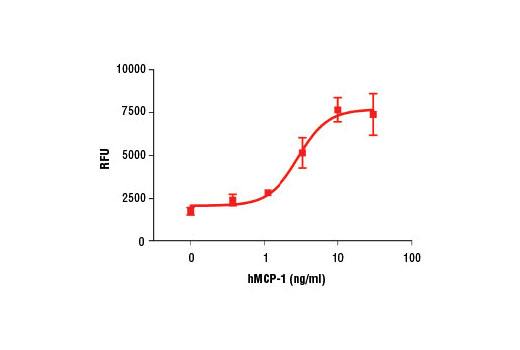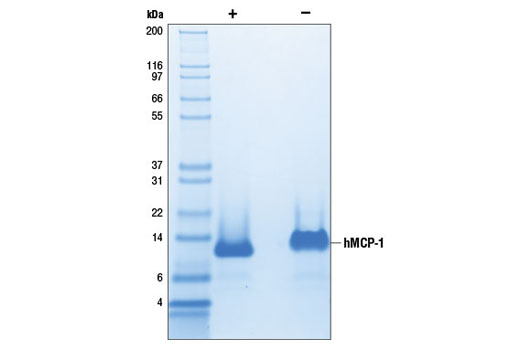8.6
#P13500
6347
Background
MCP-1 (CCL2) is the first member of the C-C family of chemokines to be identified (1). C-C chemokines are characterized by two adjacent cysteine residues within the polypeptide, which form an intra-molecular disulfide bond. MCP-1 is a potent chemotactic factor for monocytes/macrophages, T cells and a subset of NK cells (1-4). The MCP-1 receptor, CCR2, is expressed as two splice isoforms, CCR2A and CCR2B, of which CCR2B is the predominant form (1). MCP-1 is secreted by adipocytes and appears to be one of many links between obesity, inflammation, and diabetes (1). MCP-1/CCR2 signaling appears to play a key role in γδ effector T cells recruitment and anti-tumor responses in a murine B16 melanoma model (2). Conversely, CCL2 expression is upregulated in many types of cancer and has been implicated in promoting tumor cell survival, proliferation, and tumor associated inflammation (4).
Endotoxin
Less than 0.01 ng endotoxin/1 μg hMCP-1.
Purity
>95% as determined by SDS-PAGE of 6 μg reduced (+) and nonreduced (-) recombinant hMCP-1. All lots are greater than 95% pure.
Source / Purification
Recombinant Human MCP-1 (hMCP-1) Gln24-Thr99 (Accession #NP_002973) was expressed in E.coli at Cell Signaling Technology.
Bioactivity
The activity of hMCP-1 was determined using a THP-1 cell migration assay. The ED50 of each lot is between 1-11 ng/ml.
Background
MCP-1 (CCL2) is the first member of the C-C family of chemokines to be identified (1). C-C chemokines are characterized by two adjacent cysteine residues within the polypeptide, which form an intra-molecular disulfide bond. MCP-1 is a potent chemotactic factor for monocytes/macrophages, T cells and a subset of NK cells (1-4). The MCP-1 receptor, CCR2, is expressed as two splice isoforms, CCR2A and CCR2B, of which CCR2B is the predominant form (1). MCP-1 is secreted by adipocytes and appears to be one of many links between obesity, inflammation, and diabetes (1). MCP-1/CCR2 signaling appears to play a key role in γδ effector T cells recruitment and anti-tumor responses in a murine B16 melanoma model (2). Conversely, CCL2 expression is upregulated in many types of cancer and has been implicated in promoting tumor cell survival, proliferation, and tumor associated inflammation (4).
Background References
Cross-Reactivity Key
H: human M: mouse R: rat Hm: hamster Mk: monkey Vir: virus Mi: mink C: chicken Dm: D. melanogaster X: Xenopus Z: zebrafish B: bovine Dg: dog Pg: pig Sc: S. cerevisiae Ce: C. elegans Hr: horse GP: Guinea Pig Rab: rabbit All: all species expected
Trademarks and Patents
Limited Uses
Except as otherwise expressly agreed in a writing signed by a legally authorized representative of CST, the following terms apply to Products provided by CST, its affiliates or its distributors. Any Customer's terms and conditions that are in addition to, or different from, those contained herein, unless separately accepted in writing by a legally authorized representative of CST, are rejected and are of no force or effect.
Products are labeled with For Research Use Only or a similar labeling statement and have not been approved, cleared, or licensed by the FDA or other regulatory foreign or domestic entity, for any purpose. Customer shall not use any Product for any diagnostic or therapeutic purpose, or otherwise in any manner that conflicts with its labeling statement. Products sold or licensed by CST are provided for Customer as the end-user and solely for research and development uses. Any use of Product for diagnostic, prophylactic or therapeutic purposes, or any purchase of Product for resale (alone or as a component) or other commercial purpose, requires a separate license from CST. Customer shall (a) not sell, license, loan, donate or otherwise transfer or make available any Product to any third party, whether alone or in combination with other materials, or use the Products to manufacture any commercial products, (b) not copy, modify, reverse engineer, decompile, disassemble or otherwise attempt to discover the underlying structure or technology of the Products, or use the Products for the purpose of developing any products or services that would compete with CST products or services, (c) not alter or remove from the Products any trademarks, trade names, logos, patent or copyright notices or markings, (d) use the Products solely in accordance with CST Product Terms of Sale and any applicable documentation, and (e) comply with any license, terms of service or similar agreement with respect to any third party products or services used by Customer in connection with the Products.

